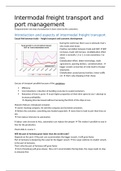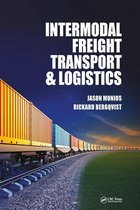Intermodal freight transport and
port management
Postponement: last step of production is done close by the customers.
Introduction and aspects of intermodal freight transport
Causal link between trade – freight transport and economic development
During the world war there was no demand, that’s
why trade went down.
Positive correlation between trade and GDP. If GDP
increases, trade will increase. (multiplication effect
which is normally 1.5 or 2, is now sometimes 3 or
more.
Globalization-effect: better technology, trade
agreements, opening borders, containerization.
bigger vessels: economies of scale lead to cheaper
shipments.
Globalization caused porous borders, lower tariffs
etc that’s why shipping is that cheap
Success of transport possible because of the containers:
Efficiency
Cost reductions: reduction of handling costs due to sealed containers
Reduction of time in ports much higher proportion of their time spend at sea = attempt to
increase profitability
shipping time decreased without increasing the KM/H of the ships at sea.
Malcolm Mclean: introduced container.
owner trucking company. He sold the company and invented containers.
Before the container: everything was loaded separately more time to load in port than time on
sea.
from labour intensive to automation
If labour costs increase in Asia, automation can replace the people This makes it possible to stay in
Asia for the production.
Check slide 6, course 1.
Will the port of Antwerp grow faster than the world trade?
Depends on the port: if the port can accommodate the bigger vessels, it will grow faster.
Port of Antwerp is deepening the canal for the bigger vessels the cargo switches to smaller vessels
in the port of Antwerp.
That’s why the port of Antwerp will grow faster
Port of Hamburg will grow slower, they can’t accommodate the big ships, the cargo needs to stop
in Antwerp first.
,International seaborne trade
Left graph: Five major bulks are increasing: grain, coal, Iron ore, Bauxite, phosphate. Why are they
increasing?
production is in South East Asia and the raw materials are not in SE Asia, that’s why the transport
of these resources is still increasing. (blue colour).
Right graph: Goods loaded for international shipment are assumed to be exports, while goods
unloaded from ships are assumed to be imports.
Unloaded is also important: raw materials come from somewhere else and they need to get to SE
Asia.
Oceania: more loaded they are major producer of ore and coal, they ship it to SE Asia, that’s why
there’s more loaded.
Check slide 12 – 24 (illustration)
Transport:
All socio-economic efforts the society needs to perform to move people, goods and messages
between two places
Essential for the functioning of the economy and social structure
Does not exist on its own result of a primary need of goods and services
DERIVED demand: it can’t exist on its own. Transport only exists if there is demand
somewhere else. Derived from production or consumption.
Transport results in an increase of value = complementary character
goods are going to a place where they can be of more use
Demand for transport is place- and time dependent:
Transport is a service that needs to be delivered and consumed immediate, no stock or
storage of transport activities is possible
Demand differs in time:
peaks/ irregular evolution over time
Daily/ seasonal/ long term fluctuations Results from derived demand
= economic system with three essential elements:
o Means of displacement
o Traffic infrastructure
o Load (people or goods)
,Division of transport according to criteria
According to way of transport
water, land, air, …
According to means of transport
Truck, rail, pipeline, barge, airplane
According to object
People of Goods transport
According to distance
Short distance (lokal or regional) or
Long distance (continental or intercontinental)
According to the frequency of the transport service
o Line traffic: irrespective the demand: eg bus drives each 30 minutes, even if there are
no people.
o Tramp traffic: service dependent on the demand for transport, aiming for a
maximised filling rate
According to the time of operation
Transport at own expense or transport for a third party (make or buy decision)
…
Multimodal transport:
= Use of more than one mode in a transport chain (eg. Road and water)
goods are loaded from one mode into the other
≠ combined transport = Largest part of the trajectory is done by barge or rail, last mile transport is
done by road
Two possible techniques:
Lift-on/ lift-off vertical technique with cranes
most common but most expensive
Roll-on/ Roll-off horizontal technique
Rolled on and off board
Intermodal transport:
Goods remain in the same loading unit (eg. Container)
“Transport of unitised cargo through more than one transport modality and the cargo is not
touched with the transhipment” container is sealed.
“Transport system that combines and integrates different transport modes, resulting in door-
to-door services”
Two different system elements:
Fixed components
Long lifespan, expensive to replace, large amount necessary to be efficient, financed by
governments, monopoly in exploitation
E.g. railway tracks.
, Mobile goods of capital
short lifespan, relatively cheap to replace, no entry barriers, flexible
E.g. everyone can start trucking company.
Determinants of location:
Transport costs (25% of the revenue)
Speed
Accessibility
…
Transport possibilities is a location determining factor: Firms try to minimalize the transport costs.
Ports, canals, .. around railway tracks are ideal for a location.
other locational factors are: availability of industrial areas, availability of labour, education,
proximity of market, fiscal climate, ..
An improvement of transport (fixed or mobile component) can reduce the costs of transport and
enlarge market possibilities.
Choice of transport depends on speed, usability, risk for damage, cost, availability, …
Speed is important for:
Producer: capital is only shortly involved
Consumer: gets its products much faster
Transporter: higher degree of use of capacity of material
The blue banana (red in this picture)
Highest concentration of people, industry and money
on this banana. Blue (red in picture) because it’s the
colour of Europe.
This picture is the blue banana combined with a
yellow one. The blue is from London to north Italy,
this one also includes Spain.
The last part does not exist anymore.
The blue lines to the east are points with good
infrastructure. There are certain hubs in eastern EU.
it will not entirely shift to the east:
Big population but it’s aging rapidly: not so many young people
Brain drain: young talented people come to the west.
Most attractive regions are Belgium, France, Germany, Netherlands.
Goods can also be categorised based upon their value:
High value goods can bear high costs of transport
Also perishable goods, goods with an urgent need (such as pharmaceutical products), luxury
products (such as diamants) and products that diminish fastly in value (such as fashion) can
bear more expensive transport
Goods with average value
Semi-manufactured products with limited manufacturing costs





